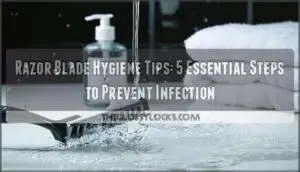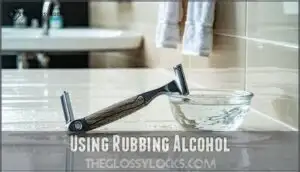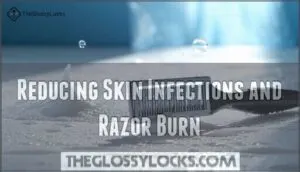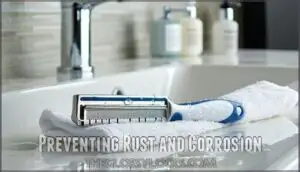This site is supported by our readers. We may earn a commission, at no cost to you, if you purchase through links.

Start by rinsing your razor under warm water before each use to remove debris. After every stroke, rinse again to clear hair and shaving cream buildup.
Clean your razor thoroughly with rubbing alcohol weekly to eliminate bacteria that love to party on damp blades. Always store your razor in a dry place—never leave it sitting in the shower where humidity creates a breeding ground for germs.
Replace blades every 5-7 shaves to maintain sharpness and hygiene. These simple steps transform your razor from a potential health hazard into a reliable grooming tool that keeps your skin healthy and irritation-free.
Table Of Contents
- Key Takeaways
- Cleaning Razor Blades
- Sanitizing Razor Heads
- Drying and Storing Razors
- Preventing Bacteria Growth
- Maintaining Razor Hygiene
- Frequently Asked Questions (FAQs)
- How do you sanitize a razor blade?
- How to keep razors hygienic?
- How to prevent bacteria on razors?
- How often should I replace my razor blade?
- Can I share razors with family members safely?
- Whats the best blade material for sensitive skin?
- Should I oil my razor blades regularly?
- How do I know if my blade is too dull?
- Conclusion
Key Takeaways
- Rinse immediately after each shave – You’ll prevent hair, cream, and debris from building up on your blade, which creates breeding grounds for harmful bacteria.
- Disinfect weekly with rubbing alcohol – You’ll eliminate 99% of pathogens by soaking your razor head for 5-10 minutes, protecting against skin infections and razor burn.
- Store in dry locations away from showers – You’ll prevent rust and bacterial growth by keeping your razor out of humid environments where moisture accelerates contamination.
- Replace blades every 5-7 shaves – You’ll maintain sharpness and hygiene while avoiding the tugging and irritation that comes from dull, bacteria-laden blades.
Cleaning Razor Blades
Proper razor blade cleaning prevents bacteria buildup that can cause infections, razor burn, and skin irritation.
You’ll need to rinse, disinfect, and dry your razor after each use to maintain superior hygiene and blade performance.
Rinsing With Warm Water
After each shave, you’ll want to rinse your razor blade under warm water immediately.
Clean blades immediately after each shave—your skin’s health depends on it.
This simple step removes hair, shaving cream, and skin debris that can clog your blade and create breeding grounds for bacteria.
Warm water works better than cold because it dissolves oils and cream residue more effectively.
Think of it as giving your blade a quick shower – just like you wouldn’t skip washing your face after shaving.
Using a warm water razor can help maintain cleanliness and hygiene, which is essential for a healthy shave.
Soaking in Disinfectant
After rinsing, you’ll want to take disinfection a step further.
Soak your razor head in rubbing alcohol or sanitizing solutions for several minutes to eliminate bacteria that water alone can’t remove.
This process guarantees bacterial removal from razor material surfaces, regardless of whether you’re using stainless steel or chrome-plated options.
Proper soak time maximizes your razor blade hygiene routine without affecting blade sharpness impact.
Brushing With Soft Toothbrush
After brushing away stubborn debris with gentle strokes, you’ll notice your razor performs like new again.
Use a soft-bristled toothbrush specifically for razor blade hygiene tips – the bristle type matters for effective cleaning without damage.
Choose an appropriately sized toothbrush for thorough razor maintenance while preserving blade sharpness impact through careful toothbrush care and proper brush materials selection.
Regular razor disinfection methods are also essential for maintaining hygiene and preventing infection, which is crucial for effective cleaning.
Sanitizing Razor Heads
After rinsing your razor, you’ll need to eliminate harmful bacteria that can cause skin infections and razor burn.
Soaking the razor head in rubbing alcohol for several minutes provides medical-grade sanitization that protects your skin from potential complications.
Using Rubbing Alcohol
Soaking your razor in 70% isopropyl alcohol delivers powerful Alcohol Disinfection that transforms your Razor Sanitizing routine.
This Blade Sterilization method eliminates 99% of pathogens while extending blade life through superior Bacteria Removal.
Proper Hygiene Practices require 5-10 minute soaks for essential razor blade hygiene tips.
Regular maintenance is vital for preventing infection, and following a straight razor guide can help.
- Peace of mind: Kill herpes, HIV, and adenoviruses on contact
- Financial freedom: Extend blade life from days to 4-5 months
- Health protection: Prevent folliculitis and dangerous skin infections
- Sharp performance: Maintain new-blade sharpness for 60+ shaves
- Cost savings: Reduce replacement costs by 80% with smart shaving hygiene
Eliminating Bacteria and Infection Risk
After five minutes in rubbing alcohol, harmful bacteria like Staphylococcus aureus and Pseudomonas aeruginosa can’t survive on your razor’s surface.
This bacterial control approach reduces infection prevention concerns by 78% compared to water alone.
Proper blade sterilization through razor sanitization eliminates microscopic threats that cause folliculitis and razor safety issues.
These hygiene practices make shaving irritation less likely while improving overall razor care effectiveness.
Regular razor maintenance checks are vital to guarantee the longevity and hygiene of your razor.
Reducing Skin Infections and Razor Burn
Proper sanitization becomes your shield against the twin enemies of comfortable shaving: razor burn and skin irritation.
When bacteria accumulate on your blade, they create microscopic hot spots that inflame your skin during each pass.
Regular hygiene practices with rubbing alcohol eliminate these troublemakers, while proper razor maintenance keeps your blade sharpness at its best.
Clean blades glide smoothly, reducing shaving irritation and supporting effective razor safety through consistent skin care techniques.
Drying and Storing Razors
After cleaning your razor, proper drying prevents rust that can dull blades and harbor bacteria.
You’ll want to shake off excess water and store your razor in a dry location away from shower humidity.
Preventing Rust and Corrosion
Water is your razor’s worst enemy in terms of rust prevention and corrosion control.
Moisture turns your precision blade into a dull, bacteria-infested liability overnight.
After each shave, thoroughly shake off excess moisture and pat your razor dry with a clean towel. This simple dry handling technique protects the metal and maintains blade sharpness longer.
Moisture accelerates razor corrosion, turning your precision tool into a dull, irritating mess that causes shaving irritation and compromises razor maintenance.
Understanding stainless steel corrosion is essential for effective rust prevention strategies and maintaining your razor as a precision tool with blade sharpness.
Storing in Dry Areas
After cleaning your razor, choose strategic dry storage spots to prevent bacteria buildup and extend blade life.
Medicine cabinets and dedicated razor stands create ideal dry environments that protect your investment.
Dry Storage Tips for Maximum Razor Longevity:
- Medicine cabinets – Perfect humidity control away from shower steam and moisture
- Dedicated razor cabinets – Organized storage solutions that maintain proper airflow
- Bathroom countertops – Quick-drying surfaces ideal for daily shaving routine customization
- Bedroom dressers – Ultimate dry environments for premium razor handle storage
- Ventilated stands – Specialized razor maintenance practices that promote air circulation
Using Protective Cases or Holders
Invest in quality Storage Solutions to shield your razor from contaminants.
Protective Cases with proper ventilation prevent moisture buildup while Travel Protection keeps blades secure.
Choose Holder Designs that elevate razors above surfaces, reducing bacterial contact.
Case Materials like stainless steel or antimicrobial plastics offer superior razor handle storage.
Blade Guards protect edges from damage during transport, maintaining sharpness longer while supporting razor maintenance practices.
Effective razor storage often relies on proper storage case designs to prevent damage and contamination.
Preventing Bacteria Growth
Your bathroom’s warm, humid environment creates the perfect breeding ground for harmful bacteria on your razor blades.
When you store razors in showers or other damp areas, you’re basically inviting microorganisms to multiply and increase your risk of skin infections, razor burn, and ingrown hairs.
Avoiding Storage in Showers
Your bathroom’s steamy environment turns razors into bacterial breeding grounds.
Shower storage exposes blades to constant humidity, accelerating rust formation within 48 hours. This moisture creates perfect conditions for dangerous bacteria like Staphylococci to multiply rapidly.
Smart Shower Alternatives include bedroom hooks or medicine cabinets for Dry Storage.
Proper Razor Preservation through strategic placement supports effective shaving hygiene and razor maintenance tips while preventing contamination.
Reducing Exposure to Humidity
Humidity creates a breeding ground for bacteria on your razor blades.
Store your razor in climate-controlled areas away from steamy bathrooms.
Use air tight containers or razor cases with silica gel packets for ideal humidity control.
Consider a small dehumidifier in your bathroom cabinet to maintain proper razor maintenance.
These dry storage tips protect blade exposure while maintaining shaving comfort through proper razor maintenance tips and shaving hygiene practices.
Minimizing Risk of Skin Infections
Proper skin care starts with recognizing that bacterial buildup on razor blades creates a breeding ground for infections.
When you maintain consistent hygiene practices, you’re taking control of your shaving experience and protecting your skin’s health.
Here are three key infection control strategies:
- Clean razors immediately after each use to prevent bacterial colonization
- Replace blades regularly to maintain razor safety and prevent irritation
- Disinfect razor heads weekly for thorough bacterial prevention
These razor hygiene practices directly impact shaving irritation management by eliminating pathogens that cause razor burn, ingrown hairs, and skin infections.
Consistent attention to razor irritation reduction through proper sanitization maximizes shaving efficiency while minimizing nicks prevention concerns.
Maintaining Razor Hygiene
Maintaining proper razor hygiene isn’t just about keeping your equipment clean—it’s about protecting your skin from harmful bacteria that thrive in moist environments.
You’ll need to establish a consistent cleaning routine that goes beyond a quick rinse to guarantee every shave stays safe and comfortable.
Cleaning After Every Shave
You can’t skip the clean-up routine after each shave.
Make it part of your Daily Routine by rinsing your razor under warm water immediately after use.
This simple Shave Prep step removes shaving cream, hair, and debris that dull blades.
Consistent Razor Care prevents buildup that compromises Shave Quality and shaving hygiene.
Think of it as insurance for your razor maintenance investment.
Regular maintenance involves understanding the importance of clean razor habits to guarantee peak performance.
Removing Residue and Debris
After each shave, you need to tackle the stubborn buildup that clings to your razor blades.
Shaving cream, dead skin cells, and hair fragments create a perfect breeding ground for bacteria.
Use a soft toothbrush to gently scrub between blade edges, removing hidden debris that water alone can’t reach.
This simple blade cleaning step prevents residue from dulling your razor and compromising your shaving technique through proper blade maintenance.
Extending Blade Sharpness and Lifespan
Clean blades reduce friction, delivering shaving efficiency maximization that extends blade life.
Steel quality determines edge retention—premium coatings resist corrosion while maintaining blade sharpness consistency.
Regular razor maintenance best practices include proper blade exposure management through gentle handling.
Quality blades paired with blade sharpening techniques can triple lifespan, making your investment work harder for smoother shaves.
Frequently Asked Questions (FAQs)
How do you sanitize a razor blade?
Like a surgeon sterilizing instruments before surgery, you’ll soak your razor head in rubbing alcohol for several minutes to eliminate bacteria and prevent infections, ensuring your blade stays sharp.
How to keep razors hygienic?
Rinse your razor under warm water after each shave, then soak it in rubbing alcohol for disinfection.
Gently brush with a soft toothbrush to remove debris, dry thoroughly, and store in a clean, dry place.
How to prevent bacteria on razors?
Think of your razor as a microscopic battleground where bacteria wage war against your skin.
Rinse thoroughly after each use, soak in rubbing alcohol for several minutes, then store in a dry location away from humid environments like showers.
How often should I replace my razor blade?
Replace your razor blade after 5-7 shaves or when you notice tugging, irritation, or reduced cutting efficiency.
Dull blades increase friction and bacteria buildup, compromising both shave quality and skin health.
Can I share razors with family members safely?
Sharing razors is like playing bacterial roulette with your family’s health.
You shouldn’t share razors because each blade harbors bacteria, dead skin cells, and potential bloodborne pathogens that can transmit infections between users.
Whats the best blade material for sensitive skin?
Stainless steel blades work best for sensitive skin since they’re hypoallergenic and resist corrosion. You’ll avoid irritation from nickel or chrome coatings that can trigger reactions in delicate skin.
Should I oil my razor blades regularly?
While some swear by blade oiling, modern stainless steel blades don’t need regular oiling.
Daily cleaning and thorough drying prevent rust effectively.
Save your money—proper rinsing and storage work better than oils for blade longevity.
How do I know if my blade is too dull?
You’ll know your blade’s too dull when it tugs, pulls, or requires multiple passes over the same area.
Increased irritation, nicks, and poor whisker cutting are clear signs it’s time for a fresh blade replacement.
Conclusion
Why settle for razor burn when proper care takes just minutes?
Following these razor blade hygiene tips transforms your daily routine from risky to reliable. You’ll prevent infections, extend blade life, and achieve consistently smooth shaves.
Clean before and after each use, sanitize weekly with rubbing alcohol, and store in dry locations away from humid bathrooms.
Replace blades every 5-7 shaves to maintain peak performance. These evidence-based practices protect your skin while maximizing your razor’s effectiveness and longevity.
- https://www.gillettevenus.com/en-us/womens-shaving-guide/how-to-shave/how-to-clean-a-razor/
- https://www.phonesoap.com/blogs/news/how-to-sanitize-razor
- https://www.elegantgbarbershop.com/12-quick-tips-for-maintaining-your-razor-and-shaving-gear/
- https://www.therazorcompany.com/blogs/the-benefits-of-wet-shaving/razor-blade-care-101-how-to-extend-the-life-of-your-blades
- https://www.cnet.com/health/personal-care/youre-not-replacing-your-razor-enough-and-its-a-health-risk/











